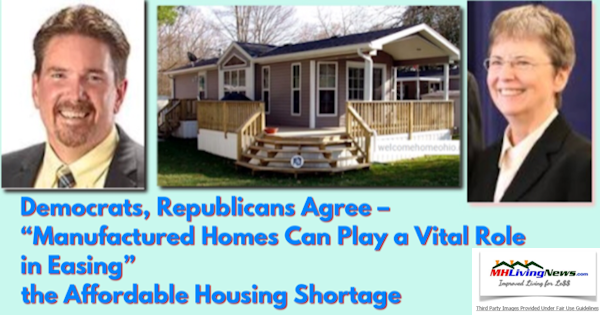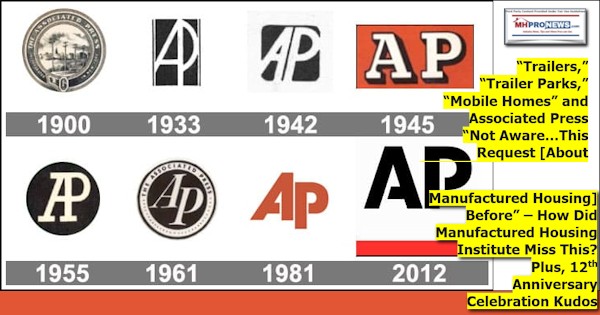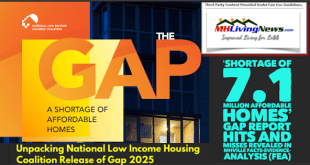The following is from the U.S. Census Bureau. Explanation of the symbols and other details are found below the table ranking each state and jurisdiction shown by the percentage of housing units that are manufactured or mobile homes (Part I). Note that while the table below this infographic does not make a distinction between what percentage of housing units were built before or after the HUD Code for manufactured housing went into effect, statistically most homes will be manufactured homes, not mobile homes. Part II will have another table that includes the manufactured home production by year since 1995 to 2023. Part III provides links to more third-party research, home shopping tips including mortgage/lending insights, and other useful information.

Part I
| Table ID: | R2501 | |||
| Table Name: | PERCENT OF HOUSING UNITS THAT ARE MOBILE HOMES | |||
| Select a Geography: | United States | <— SELECT YOUR GEOGRAPHY | ||
| Estimate: | 5.6 | The Estimate and MOE are automatically | ||
| Margin of Error: | +/-0.1 | filled in once Geography is selected. | ||
| RANK | GEOGRAPHY | ESTIMATE | MARGIN_OF_ERROR |
| United States | 5.6 | +/-0.1 | |
| 1 | New Mexico | 15.5 | +/-0.6 |
| 2 | Mississippi | 15.0 | +/-0.5 |
| 3 | South Carolina | 14.2 | +/-0.4 |
| 4 | West Virginia | 13.8 | +/-0.6 |
| 5 | Louisiana | 12.6 | +/-0.4 |
| 6 | Alabama | 12.2 | +/-0.3 |
| 7 | Arkansas | 11.4 | +/-0.4 |
| 8 | Wyoming | 11.3 | +/-0.9 |
| 9 | Kentucky | 10.9 | +/-0.4 |
| 10 | North Carolina | 10.8 | +/-0.3 |
| 11 | Arizona | 8.9 | +/-0.3 |
| 11 | Montana | 8.9 | +/-0.7 |
| 13 | Oklahoma | 8.5 | +/-0.3 |
| 14 | Tennessee | 8.3 | +/-0.3 |
| 15 | Florida | 8.2 | +/-0.1 |
| 16 | Georgia | 8.0 | +/-0.2 |
| 17 | Maine | 7.9 | +/-0.5 |
| 18 | North Dakota | 7.5 | +/-0.7 |
| 19 | South Dakota | 6.9 | +/-0.5 |
| 20 | Idaho | 6.8 | +/-0.5 |
| 20 | Oregon | 6.8 | +/-0.3 |
| 22 | Delaware | 6.5 | +/-0.7 |
| 23 | Texas | 6.3 | +/-0.2 |
| 24 | Vermont | 5.5 | +/-0.5 |
| 25 | Washington | 5.4 | +/-0.2 |
| 26 | Missouri | 5.3 | +/-0.2 |
| 26 | Nevada | 5.3 | +/-0.3 |
| 28 | Michigan | 5.2 | +/-0.2 |
| 29 | New Hampshire | 4.8 | +/-0.4 |
| 30 | Indiana | 4.3 | +/-0.2 |
| 30 | Virginia | 4.3 | +/-0.2 |
| 32 | Kansas | 4.0 | +/-0.2 |
| 33 | Alaska | 3.7 | +/-0.5 |
| 34 | Colorado | 3.6 | +/-0.2 |
| 35 | California | 3.5 | +/-0.1 |
| 35 | Pennsylvania | 3.5 | +/-0.1 |
| 37 | Ohio | 3.4 | +/-0.1 |
| 38 | Iowa | 3.1 | +/-0.2 |
| 38 | Wisconsin | 3.1 | +/-0.1 |
| 40 | Minnesota | 2.9 | +/-0.1 |
| 40 | Utah | 2.9 | +/-0.3 |
| 42 | Nebraska | 2.6 | +/-0.2 |
| 43 | Illinois | 2.2 | +/-0.1 |
| 44 | New York | 2.1 | +/-0.1 |
| 45 | Maryland | 1.3 | +/-0.1 |
| 46 | New Jersey | 1.0 | +/-0.1 |
| 47 | Connecticut | 0.8 | +/-0.1 |
| 47 | Massachusetts | 0.8 | +/-0.1 |
| 47 | Rhode Island | 0.8 | +/-0.2 |
| 50 | Hawaii | 0.3 | +/-0.1 |
| 51 | District of Columbia | 0.0 | +/-0.1 |
| Puerto Rico | 0.3 | +/-0.1 | |
| Source: U.S. Census Bureau, 2022 American Community Survey 1-Year Estimates | |||
Source: U.S. Census Bureau, 2022 American Community Survey 1-Year Estimates
Information about the American Community Survey (ACS) can be found on the ACS website.
Supporting documentation including code lists, subject definitions, data accuracy, and statistical testing, and a full list of ACS tables and table shells (without estimates) can be found on the Technical Documentation section of the ACS website.
Sample size and data quality measures (including coverage rates, allocation rates, and response rates) can be found on the American Community Survey website in the Methodology section.
Although the American Community Survey (ACS) produces population, demographic and housing unit estimates, the decennial census is the official source of population totals for April 1st of each decennial year. In between censuses, the Census Bureau’s Population Estimates Program produces and disseminates the official estimates of the population for the nation, states, counties, cities, and towns and estimates of housing units for states and counties.
Data are based on a sample and are subject to sampling variability. The degree of uncertainty for an estimate arising from sampling variability is represented through the use of a margin of error. The value shown here is the 90 percent margin of error. The margin of error can be interpreted roughly as providing a 90 percent probability that the interval defined by the estimate minus the margin of error and the estimate plus the margin of error (the lower and upper confidence bounds) contains the true value. In addition to sampling variability, the ACS estimates are subject to nonsampling error (for a discussion of nonsampling variability, see ACS Technical Documentation). The effect of nonsampling error is not represented in these tables.
The 2022 American Community Survey (ACS) data generally reflect the March 2020 Office of Management and Budget (OMB) delineations of metropolitan and micropolitan statistical areas. In certain instances the names, codes, and boundaries of the principal cities shown in ACS tables may differ from the OMB delineations due to differences in the effective dates of the geographic entities.
Explanation of Symbols:
– The estimate could not be computed because there were an insufficient number of sample observations. For a ratio of medians estimate, one or both of the median estimates falls in the lowest interval or highest interval of an open-ended distribution. For a 5-year median estimate, the margin of error associated with a median was larger than the median itself.
N The estimate or margin of error cannot be displayed because there were an insufficient number of sample cases in the selected geographic area.
(X) The estimate or margin of error is not applicable or not available.
median- The median falls in the lowest interval of an open-ended distribution (for example “2,500-“)
median+ The median falls in the highest interval of an open-ended distribution (for example “250,000+”).
** The margin of error could not be computed because there were an insufficient number of sample observations.
*** The margin of error could not be computed because the median falls in the lowest interval or highest interval of an open-ended distribution.
***** A margin of error is not appropriate because the corresponding estimate is controlled to an independent population or housing estimate. Effectively, the corresponding estimate has no sampling error and the margin of error may be treated as zero.
Part II New Manufactured Home Production by Year from 1995 to 2023
| Year | Production |
|---|---|
| 1995 | 344,930 |
| 1996 | 363,345 |
| 1997 | 353,686 |
| 1998 | 373,143 |
| 1999 | 348,075 |
| 2000 | 250,366 |
| 2001 | 193,120 |
| 2002 | 165,489 |
| 2003 | 130,815 |
| 2004 | 130,748 |
| 2005 | 146,881 |
| 2006 | 117,373 |
| 2007 | 95,752 |
| 2008 | 81,457 |
| 2009 | 49,683 |
| 2010 | 50,056 |
| 2011 | 51,618 |
| 2012 | 54,881 |
| 2013 | 60,228 |
| 2014 | 64,334 |
| 2015 | 70,544 |
| 2016 | 81,136 |
| 2017 | 92,902 |
| 2018 | 96,555 |
| 2019 | 94,615 |
| 2020 | 94,390 |
| 2021 | 105,772 |
| 2022 | 112,882 |
| 2023 | 89,169 |
The most recent public data based on official data is found at the Manufactured Housing Association for Regulatory Reform (MHARR) website at this link here.
Note that manufactured home production is up in 2024, see details at this link here.

Part III – Additional Linked Reports and Insights
1) The good news about manufactured housing is that most of the concerns that people have are demonstrably outdated, based on third-party research. See reports found in the reports linked below.







2) MHLivingNews is pro-manufactured housing but advises potential home buyers to shop carefully and avoid doing business with so-called predator firms. Few manufactured home websites other than MHLivingNews and our MHProNews sister site provide as much information and evidence about concerns regarding unjust and potentially illegal business practices attributed to specific manufactured home firms. The following are just some examples. Search this site, or our sister site, by company or organization name to learn more.







3) Shopping tips are found in the videos with transcripts, graphics, and information found linked below.




##



Mobile Home and Manufactured Home Living News explores the good, bad, and ugly realities that keep the most proven form of affordable home ownership under-appreciated and misunderstood. MHLivingNews provides third-party research and other resource collections and reports not found on other sites. We also provide thought provoking analysis that are designed to open minds and hearts. This is the widely acknowledged best source for authentic news on mobile and manufactured home living, as well as the policies that impact this segment of housing that provides 22 million Americans with good, surprisingly appealing living.
We lay out the facts and insights that others can’t or won’t do. That’s what makes our sister site and this location the runaway leaders for authentic information about affordable housing in general, the politics behind the problems, and manufactured homes specifically. That’s a wrap on this installment of “News through the lens of manufactured homes and factory-built housing” © where “We Provide, You Decide.” © ## (Affordable housing, manufactured homes, reports, fact-checks, analysis, and commentary. Third-party images or content are provided under fair use guidelines for media.) (See Related Reports, further below. Text/image boxes often are hot-linked to other reports that can be access by clicking on them.)

By L.A. “Tony” Kovach – for MHLivingNews.com.
Tony earned a journalism scholarship and earned numerous awards in history and in manufactured housing. For example, he earned the prestigious Lottinville Award in history from the University of Oklahoma, where he studied history and business management. He’s a managing member and co-founder of LifeStyle Factory Homes, LLC, the parent company to MHProNews, and MHLivingNews.com. This article reflects the LLC’s and/or the writer’s position, and may or may not reflect the views of sponsors or supporters.
Connect on LinkedIn: http://www.linkedin.com/in/latonykovach
Recent and Related Reports:
The text/image boxes below are linked to other reports, which can be accessed by clicking on them.



 manufacturedhomelivingnews.com Manufactured Home Living News
manufacturedhomelivingnews.com Manufactured Home Living News































